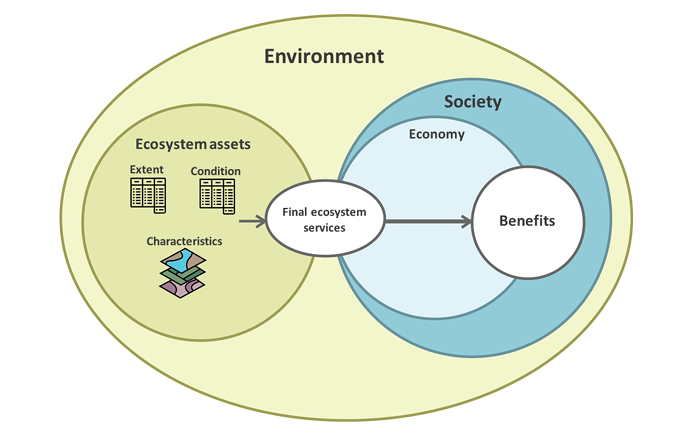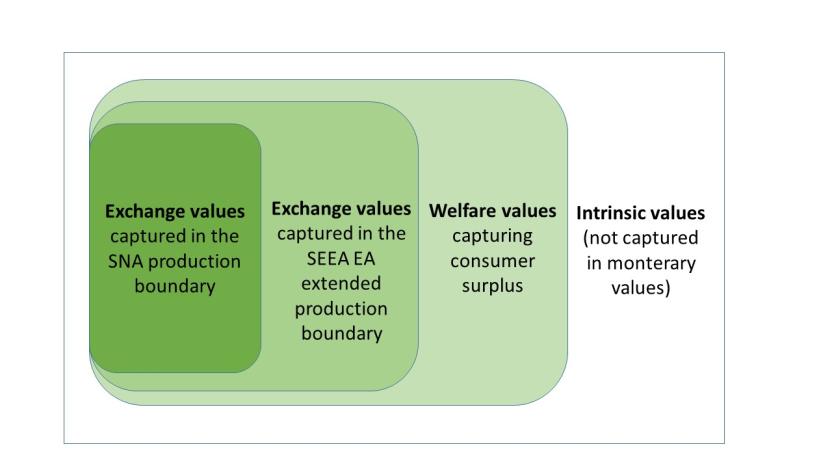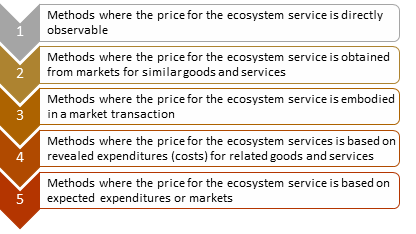The National Ecosystem Accounts will build on other ecosystem accounting work completed both within Australia and internationally in recent years including:
- National Ocean Account, Experimental Estimates, November 2022 | Australian Bureau of Statistics
- Mitchell Catchment accounts
- Experimental Environmental-Economic Accounts for the Great Barrier Reef, 2017 | Australian Bureau of Statistics
- Regional Ecosystem Accounting Pilot for Murray-Darling Basin
- Gunbower-Koondrook-Perricoota accounts
- Ecosystem Asset Accounts for Rivers in South Africa .
The first release of the accounts will showcase the potential use of extensive ecosystem accounts and provide a platform for future enhancement feedback to address policy needs, inform environmental and economic planning, and extend usability.
The ABS and DCCEEW are partnering to develop a long-term Continuous Improvement Plan for the National Ecosystem Accounts. This appendix outlines areas that will be a focus beyond the first publication. Additional improvements will be considered based on feedback from the first release.
1.1 Identification of purpose
It is important that the accounts can be used to inform decisions. Therefore, a priority for developing the ongoing program of work is a thorough investigation of user needs to determine priority accounts and metrics that will be fit-for-purpose. Prioritisation is critical given the large number of ecosystem services across all realms. Environmental-economic accounts can serve many purposes and a broad set of potential uses for these accounts may emerge over time.
To uncover this potential, user consultation will need to be a fundamental and ongoing part of future development. Clearly ascertaining user needs will then need to be balanced with practical implementation (e.g. data sources and methods).
1.2 Selection of condition metrics
The selection of appropriate metrics, in particular to measure the condition of Australia’s ecosystems, is complex and depends on the aims and uses of the accounts. No single indicator can fully represent ecosystem quality across the range of ecosystems.
The ecosystem condition accounts are useful for providing insights into the characteristics and quality of ecosystems and how they change over time. Ecosystem condition is the quality of an ecosystem measured in terms of its abiotic and biotic characteristics (United Nations et al. 2021).
“Ecosystem condition accounts record data on the state and functioning of (ecosystem assets) ... using a combination of relevant variables and indicators. The selected variables and indicators reflect changes over time in the key characteristics of each (ecosystem asset).”
A three-stage approach is used in the SEEA EA for the compilation of ecosystem condition accounts. Outputs at each stage are relevant for policy and decision-making.
- Stage 1, key characteristics are selected and data on relevant variables are collated;
- Stage 2, a general reference condition is determined and for each variable a corresponding reference level is established that allows a condition indicator to be derived;
- Stage 3, condition indicators are normalised to support aggregation and the derivation of ecosystem condition indexes (Accounting for Ecosystem Condition).
The SEEA EA also includes the Ecosystem Condition Typology (ECT), which is a hierarchical typology for organising data on ecosystem condition characteristics. It is designed to incorporate ecosystem condition measures that cover ecosystem structure, function and composition. Table 1 shows the SEEA EA ECT (United Nations et al. 2021, p. 90).
| ECT groups and classes | |
|---|---|
| Group A: Abiotic ecosystem characteristics | |
| Class A1. Physical state characteristics: physical descriptors of the abiotic components of the ecosystem (e.g. soil structure, water availability) | |
| Class A2. Chemical state characteristics: chemical composition of abiotic ecosystem compartments (e.g. soil nutrient levels, water quality, air pollutant concentrations) | |
| Group B: Biotic ecosystem characteristics | |
| Class B1. Compositional state characteristics: composition / diversity of ecological communities at a given location and time (e.g. presence / abundance of key species, diversity of relevant species groups) | |
| Class B2. Structural state characteristics: aggregate properties (e.g. mass, density) of the whole ecosystem or its main biotic components (e.g., total biomass, canopy coverage, annual maximum normalized difference vegetation index (NDVI)) | |
| Class B3. Functional state characteristics: summary statistics (e.g. frequency, intensity) of the biological, chemical, and physical interactions between the main ecosystem compartments (e.g., primary productivity, community age, disturbance frequency) | |
| Group C: Landscape level characteristics | |
| Class C1. Landscape and seascape characteristics: metrics describing mosaics of ecosystem types at coarse (landscape, seascape) spatial scales (e.g. landscape diversity, connectivity, fragmentation) | |
While a number of condition metrics will be included in the first release, future releases aim to extend the range of variables included to meet a wider range of uses. It is important, for example, that the metrics used align with jurisdictional approaches to measuring ecosystem condition across various Nature Positive initiatives. Similarly, Australia also needs to respond to international information requests related to the Global Biodiversity Framework and the Sustainability Development Goals. Thus, further work will be undertaken to refine and expand on the condition metrics used on an ongoing basis. Criteria to select condition variables will consider the relevance of the metric to the ecosystem it is measuring, the relevance of the metric for decision-making and the availability of data for ongoing reporting.
1.3 Selection of ecosystem services
Ecosystem services are the contributions of ecosystems to the benefits used in economic and other human activity (United Nations et al. 2021, para. 6.9). Examples of ecosystem services include:
- provisioning services, such as water provisioning
- regulation and maintenance services, such as global climate regulation services through the retention and sequestration of carbon in ecosystems
- cultural services, such as recreation-related services.
Once identified these ecosystem services can be valued, which also provides a value to the underlying ecosystem asset. Further information on the approaches to valuation of ecosystem services is provided in Appendix 2 - Valuing the economic contributions of ecosystems.
While there is an extensive list of ecosystem services that are provided by the environment, it is unrealistic to produce accounts that cover all these services. Instead, the accounts will focus on services that have particular relevance to policy and decision-makers. The selection of ecosystem services for inclusion in the first release will include agricultural biomass provisioning, water provisioning, coastal protection, wild fish provisioning and carbon sequestration and retention. The intention is to expand this list of ecosystem services in response to future needs.
1.4 Selection of datasets
Ecosystem accounting presents challenges in collating and harmonising environmental and economic data from a range of sources. Input data could be quantitative, qualitative, modelled, surveyed, time series, or spatial, and may vary in format, processing and scale. A framework to guide selection and harmonisation for the production of accounts is essential. It also provides guidance on when to acknowledge that the available data is not adequate, and therefore data gaps are identified. A framework allows us to:
- identify the data or other forms of information needed for accounting purposes
- encourage the development of common metadata standards
- provide greater transparency in verifying data treatments and assumptions used in compiling accounts.
The data selection framework will incorporate and expand on the ABS’s data quality framework (The ABS Data Quality Framework ) and align with DCCEEW’s draft National Data Standards (National Environmental Standards - DCCEEW). These standards include the following criteria:
- Fit-for-purpose: data and information meet the specific needs of the decision being made.
- Ethical: data and information are demonstrably compliant with relevant legislation protecting sensitive data and information, were obtained and are managed under appropriate ethics approvals, and were obtained and are managed in a transparent and inclusive manner for stakeholders.
- Reliable: data and information have a demonstrably robust scientific foundation and/or were collected under a recognised and enduring survey protocol or traditional knowledge system.
- Reusable: data and information have adequate metadata (on the data’s structure, lineage, sources, objectives and intended use) to ensure it is meaningful for decision-making.
- Accessible: data and information are made available under the least restrictive conditions possible (preferably Creative-Commons-No-Rights-Reserved).
- Discoverable: data and information are made available on an enduring, searchable and interoperable platform so they can be readily found when needed for a decision.
Assessing the quality and appropriateness of data for inclusion in the accounts depends on a number of factors. Having a framework to guide input data selection will enhance the ability of the ABS to compile high quality accounts.
The data selected for the initial release of the accounts is focused on data in a ready-to-use form, with the most important consideration being spatial coverage of the entire extent of the territory. As the accounts develop, there will be a need to look further than immediately usable data sources, so that inputs can be considered best-available and compatible with higher resolution datasets that exist for the various states and territories and other land management bodies around Australia. The development of the ongoing accounts program will include a systematic review of data sources around Australia and the construction of an objective framework, to assess datasets for suitability for the accounts, in order to provide a transparent approach to data selection.
1.5 Integrating diverse datasets
Acknowledging that a systematic review of data sources around Australia will produce many datasets that may meet many of the data quality criteria, but do not have the full spatial coverage needed - methods to modify and improve the usability of these datasets will greatly increase the ability to incorporate high quality data in the accounts. To incorporate best-possible data into the accounts, and ensure coherence with state environmental reporting, it will be important to integrate sub-national data into the national scale accounts. Considerations in developing these methods include:
- the importance of good quality partial-coverage data that can be extended
- the importance of acknowledging knowledge gaps where appropriate
- the importance of on-ground measurements, observations and monitoring
- the importance of remote-sensing datasets
- the possibility of establishing national datasets by pursuing equivalence or compatibility between sub-national data
- the possibility of a multiscale approach in accounts (e.g. using best-quality data where available, even without national coverage, and using coarser data where the high-resolution product is not available).
Continuous improvement is an inherent element of an ongoing program of ecosystem accounts. The above information provides some detail around where improvements are needed - the assessment of user needs and the refinement of data selection and development will be a continuous process that is part of the account development.
1.6 Consideration of account development concepts
The development of any statistical product relies on the use of a range of statistical concepts, standards and frameworks. A discussion of these frameworks and classifications as they relate to ecosystem accounts is provided below. The integration of standards (which define the concepts we are working on), classifications (which categorise the observations we are collecting) and methods (how we manipulate data to fit into the classifications and thus into the standard) defines the process of account compilation.
1.6.1 Standards and classifications overview
Standard classifications and definitions of statistical units and items underlie the compilation and presentation of statistics produced by national statistical offices, such as the ABS. The use of such standards ensure that statistics are harmonised across national and international boundaries, which ensures comparability and aggregation from various collections, for example, for national accounts purposes.
Where possible established Australian and international standards should be used. Comprehensibility is also a key consideration - this is the ability to be understood, by users and by respondents. It involves clarity of definitions, realism in the sense of modelling the real world, and providing a logical and coherent structure for collecting and organising information.
The widespread use of standards also provides an integrated statistical picture of Australian society and environment. They facilitate the process of drawing together all the data about a particular topic, variable or population, from the full range of statistical sources, in a meaningful and useful way.
Classifications are an important part of any standard. They are used to collect and organise information into categories with other similar pieces of information. Classifications should be exhaustive and mutually exclusive. The application of classifications can be at any level of data and at any point in the account compilation process. For example, classifications that define the inputs into the accounts, for instance the association of ecosystem types to basic statistical unit, can be different to what is reported at the account level. While it is preferable that all classifications align from collection to indicators, this is rare as most accounts are built from a wide range of data collected for different purposes.
1.6.2 Ecosystem account classifications
Ecosystem classifications must describe the components of ecosystems that are currently available to society and how these components have changed over time.
Recognised standards for SEEA ecosystem types and ecosystem services are:
- International Union for Conservation of Nature (IUCN) Global Ecosystem Typology (GET) for ecosystem types
- Common International Classification of Ecosystem Services (CICES) for ecosystem services (a shorter list is in the SEEA EA).
Ecosystem extent (IUCN GET)
The IUCN Global Ecosystem Typology (IUCN GET) is the international statistical standard for classifying ecosystems and is recommended for use in SEEA ecosystem accounting. It is a comprehensive framework for Earth’s ecosystems that integrates their functional and compositional features.
The National Ecosystem Accounts first release will use the IUCN GET levels 1 to 3 as its output ecosystem classification – 1. Realms, 2. Biomes and 3. Functional Groups. These are defined as (Typology - Global Ecosystem Typology (global-ecosystems.org):
Realm
One of five major components of the biosphere that differ fundamentally in ecosystem organisation and function: terrestrial, freshwater, marine, subterranean, atmospheric, and combinations of these (transitional realms). Because variation in nature is continuous, we also include transitional realms, where the realms meet and have their own unique organisation and function.
Biome
A component of a realm united by broad features of ecosystem structure and one or a few common major ecological drivers that regulate major ecological functions, derived from the top-down by subdivision of realms (level 1).
Ecosystem Functional Group
A group of related ecosystems within a biome that share common ecological drivers, which in turn promote similar biotic traits that characterise the group. Derived from the top-down by subdivision of biomes.
Ecosystem assets will be reported by level 3 functional group, where possible. The use of the IUCN GET does not preclude the use of different classifications systems if they are hierarchically compatible, or already in use and associated with useful data.
The accounts will adopt a more detailed ecosystem classification typology for Australia for subsequent releases when a national classification has been developed.
Ecosystem services (CICES)
Standardisation in the way ecosystem services are described is necessary for comparisons over time and between countries. It is especially important where the link to economic accounting is to be made. The CICES framework has been developed in consultation with the United Nations Statistical Division and the European Environment Agency in support of the SEEA Principles. The aim of CICES is to provide clarity on how ecosystem services are measured and analysed. CICES recognises three main categories of ecosystem outputs: provisioning, regulating and cultural services. Supporting, or indirect, ecosystem services are not explicitly expressed and are instead treated as part of the underlying structures, process and functions that characterise ecosystems. Final ecosystem services are described using a five-level hierarchical structure, with each level being progressively more detailed and specific.



